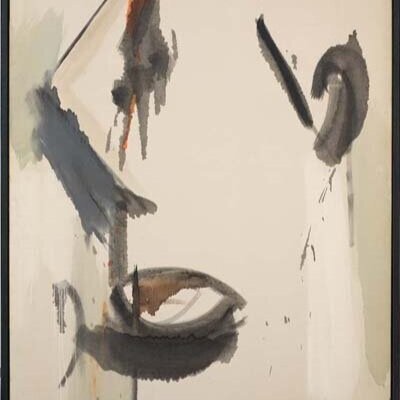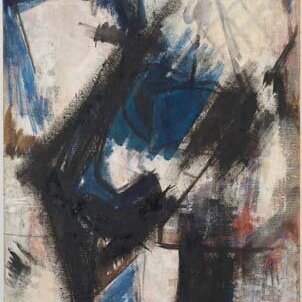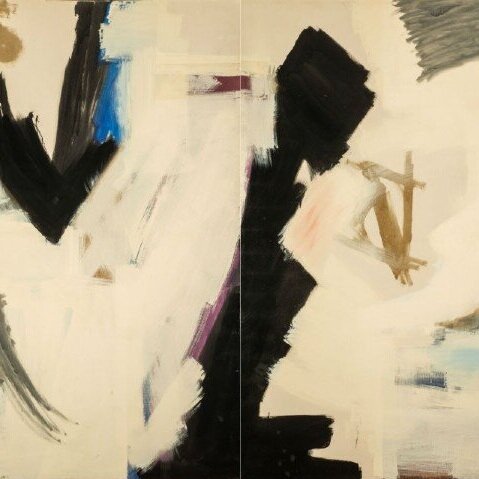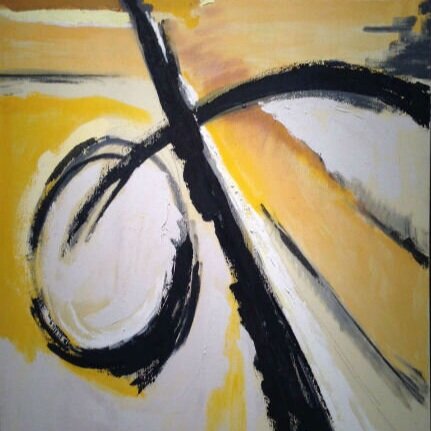The Divine Dozen: Judith Godwin – A Life in Art
Abstract expressionist Judith Godwin was born to paint.
One of only three artists still living and working out of the twelve women featured in the 2016 Denver Art Museum’s Women of Abstract Expressionism exhibition, Judith Godwin’s art knocks you off your feet the moment you enter her space in the gallery. My favorite among her featured paintings is Woman (shown here to the left), but any one of the three on display demonstrates that here are the works of a bold, powerful master who deserves to be known as widely as any of the major male painters of her genre. That she has not received as much recognition as they have is, in my opinion, a damned shame!
But time can redeem that and I’m here to introduce you to Judith if you don’t know her and her work—and to remind you of her accomplishments if you do.
Born in Suffolk, Virginia, as a child Godwin drew and painted and shared her parents’ interest in architecture and gardening. In 1950, while attending Mary Baldwin College in Staunton, she saw a performance by modern-dance pioneer Martha Graham, whose influence on dance has been compared with the influence of Picasso on modern visual arts. Judith was mesmerized by Graham’s gestures and movements and the two women became lifelong friends. Many of Godwin’s paintings reflect a similar sense of flight and elegant spatial comprehension and, in 1956, she produced Martha Graham—Lamentation (see image below), an homage to the famed dancer and choreographer.
Godwin moved to New York following completion of her degree at Richmond Professional Institute (now Virginia Commonwealth University–VCU) in 1952. Her advanced studies were with Hans Hofmann in New York and Provincetown where she immersed herself in a community of artists from all over the world and expanded her awareness of modern art. She had a cheap apartment in the Meat Market district, became fast friends with Franz Kline, showed in Eleanor Ward’s Stable Gallery (1958) and at Betty Parsons Gallery’s Section Eleven. It was an exciting time.
Godwin at work.
During these years and those that followed, her paintings reflected some major influences, such as Hofmann’s color principles and structural relationships between figurative and nonfigurative elements. Sweeping, broad gesture, arcs, and geometrics reminiscent of dance moves appeared, as did nuances of her developing interest in Zen Buddhism. In the video interview listed at the end of this post, she reminisces that she “felt free to do whatever I wanted to do.” Judith did not shy from larger-than-life statements and loved working on a grand scale; her understanding and mastery of prismatic color is superb. She had, in common with all of the artists in the DAM show, an ability to persevere. As she says,
How my paintings appear to others is not a concern while I am working. Neither do I intellectualize about a work. I prefer to leave a canvas unfinished for an extended period rather than make instant revisions. I hope that viewers of my work, being innately sensitive to color and movement, respond to some of the excitement, subtlety, discovery and idealism I have experienced in the best of it.
Her process begins with the basics:
I usually stretch and prime my own canvas. This is, to me, part of my craft. I most often begin by envisioning form and space in nature and then interpret my ideas and feelings into planes of color on the canvas. When I recognize an emerging form, I respond intuitively by evolving complimentary sub-forms in colors and applications that feel supportive and foster development. In studying color and its behavior, I have learned to trust my intuition. I have a strong believe in my work and pursue it constantly.
If there is a common thread among the women who star in the Denver exhibition, it is a tendency for their paintings to be informed by their personal history. More often than the men, they titled their works and these were often references to people, places, or events that inspired them. Aside from that, which I feel enriches the viewer’s experience, their fearless mastery of their craft, their individual courage in piercing more traditional boundaries, and their enthusiastic drive through decades of challenging circumstances make Judith Godwin and all of the women plying their art in the field of abstract expressionism, women to admire. They are touchstones, springboards, inspiring all of us to reach for our personal best. # # #
MORE: Here’s a wonderful video at VCUarts with Judith Godwin speaking at length with Dean Emeritus Joeseph H. Seipelof. A trailer for the Denver Art Museum show includes some wonderful clips of many of the artists talking about their work.
NOTE: Accompanying the Denver Art Museum exhibition is a stunning catalog, Women of Abstract Expressionism, filled with insightful essays and images. Social media request: I hope you’ll help spread the word about this series on the Divine Dozen. If you do, please use the hashtag #womenofabex






